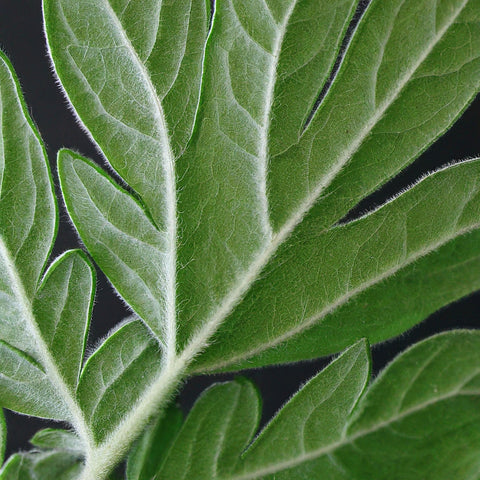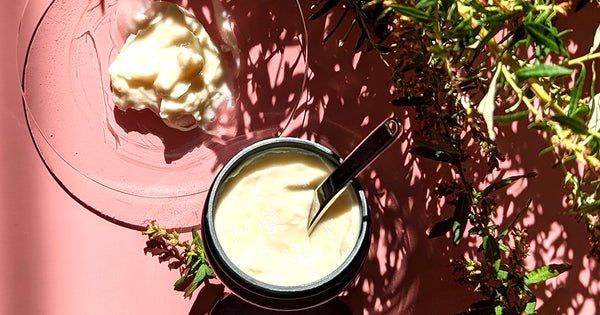
Mugwort: Your New Skincare Secret + DIY Guide
Alina FabozziFrom Seed to Skin Series
 Mugwort is a strange sip of tea. It’s highly aromatic, bitter, camphorous, minty, sagey, and salty. It induces vivid dreams when taken before bed and stimulates circulation and lymphatic flow in acupuncture.
Mugwort is a strange sip of tea. It’s highly aromatic, bitter, camphorous, minty, sagey, and salty. It induces vivid dreams when taken before bed and stimulates circulation and lymphatic flow in acupuncture.
Mugwort’s sand-like seeds have blown all over the globe and settled into every hard-scrabble nook and cranny to provide medicinal relief for everyone from the Ancient Egyptians and Chinese to the Celts, Romans, and American Indian cultures.
Potent chemical compounds in mugwort oils carry terpenoids and sesquiterpene lactones and are a rich source of drugs for the modern medical industry. For example, a semisynthetic mugwort derivative called Artemisinin treats malaria.
Beyond its physical benefits, mugwort is famed for its influence on the dream world. From inducing vibrant dreams to aiding in dream recall and even lucid dreaming, mugwort is a tool for exploring the depths of your subconscious. Whether for insight, problem-solving, or simply the thrill of conscious dreaming, mugwort opens a doorway to another realm.
Mugwort finds a purpose for our bodies as effortlessly as it takes to root on a rocky patch of earth. Whether by bath, tea, tincture, moxibustion, soup, or stew, mugwort is endlessly helpful. Let’s learn how to identify, forage, and use this dreamy little herb.
Mugwort Safety & Side Effects
 Who should avoid mugwort? If you are allergic to mugwort or its relatives like motherwort and wormwood, you should avoid handling the plant and using products with mugwort. Pregnant women should also avoid tinctures (all tinctures include alcohol), teas, and mugwort capsules. Do not take mugwort internally if you are pregnant. Why? Does it matter why? Control yourself for nine months and cool it on the tinctures.
Who should avoid mugwort? If you are allergic to mugwort or its relatives like motherwort and wormwood, you should avoid handling the plant and using products with mugwort. Pregnant women should also avoid tinctures (all tinctures include alcohol), teas, and mugwort capsules. Do not take mugwort internally if you are pregnant. Why? Does it matter why? Control yourself for nine months and cool it on the tinctures.
Mugwort Identification: What It Looks Like & Where It Grows
 I am specifically targeting common mugwort (Artemisia vulgaris), a widespread and invasive species in my area of South Jersey (Zone 7B).
I am specifically targeting common mugwort (Artemisia vulgaris), a widespread and invasive species in my area of South Jersey (Zone 7B).
- Go where the mugwort is. Mugwort thrives in diverse habitats, such as disturbed open roadsides, sunny meadows, and waterways. If you live in suburbs or rural areas, you may find it growing around your yard. If you live in the city, go to a low-maintenance nature trail. Most parks are too well-kept to have mugwort overgrowth. Mugwort grows tall, up to 6 feet. You won’t miss it!
- Learn what mugwort looks like. Once you’ve found it, pull up a few images of Artemisia vulgaris on your phone and compare. Look for deeply lobed leaves, 2-4 inches long and 1-3 inches wide. They may be fern-like, with pointed tips and uneven lobes. The top of the leaves are green, while the underside is fuzzy and silvery-white. They are typically reddish-purple and grooved, sometimes reaching 6 feet tall.
- Learn what mugwort smells like. Pluck a leaf, crush it between your fingers, and smell it. The scent will be punchy and immediate. Mugwort has a robust and earthy aroma, sometimes described as camphor, sage-like, or slightly minty. The smell is unmistakable, and there’s no other plant like it. Once you register the scent in your brain, you’ll always be able to identify mugwort. Near autumn, the stalks produce tiny white flowers with a sweet and subtle fragrance.
- Harvest responsibility. Mugwort is a prolific weed, and it’s not endangered or rare. However, it is also used by pollinators who love the sticky, nectar-rich flower clusters. With its dense root system, mugwort can fix nitrogen in the soil and control erosion. Don’t try pulling it out once it’s established; you will dislocate your shoulder. Instead, snip the thick stem at the base with pruning shears. More will grow back next year. Ask me and my aching right shoulder how I know.
Mugwort Storage: Drying, Oil Infusion, and Tincture Techniques
Now that you’ve harvested yourself 5-10 stalks of primo mugwort from the abandoned corner of a yard, it’s time to figure out what to do with it all. You need to decide ahead of time how you plan to use mugwort, and there are several options.
- Drying upside down. The simplest way to preserve mugwort is to hang the whole stalk upside-down until completely dry. Keep the stalks out of the light and away from moisture. Once dry, you can leave it hung up to use as needed or strip the branches of leaves and flowers and save it in a jar. Throw away or compost the stalks.
- Dry leaves infused in oil. Add dry mugwort plant matter to your favorite carrier oil, such as sunflower, grapeseed, avocado, or sweet almond oil. Mugwort can be stored like this for over a year if kept in a cool, dry, dark place. The oil will become infused with the scent and properties of mugwort.
- Fresh leaves in alcohol. Cover fresh mugwort leaves and flowers with 100-proof alcohol (or Everclear). This creates a potent tincture for adding to teas and drinks to induce good digestion and dreams. To start, add a 3-5 drops to your favorite beverage before bed. Remember, every person tolerates tinctures differently.
Everyday Mugwort Use:
- Dream Support: Use mugwort tea to enhance dream states. Mugwort may contribute to more vivid dreams and easier dream recall and even encourage lucid dreaming (being aware you’re dreaming). Brew one to two tablespoons of dried mugwort with your favorite accouterments. Drink hot or iced with your favorite sweetener because it is bitter. Some recipes add lemon, berries, tonic water, and other flavors to make the bitterness more tolerable. Many people drink it as is, too! As a tincture, you must experiment with different dosages according to your weight and desired effect.
- Menstrual Support: Mugwort is an emmenagogue, which may stimulate menstrual flow. Mugwort tea or tincture is sometimes used to support healthy cycles, ease cramps, and for delayed or absent periods.
- Digestive Aid: Mugwort tinctures and teas can soothe digestive issues like indigestion, bloating, and gas. Its bitter properties may stimulate digestive secretions in the gallbladder.
- Circulation & Relaxation: Mugwort is sometimes believed to support blood circulation and ease muscle tension. Use warm mugwort-infused oil to massage sore joints, pressure points, and scar tissue. Limited scientific evidence supports this, though.
- Antimicrobial: Some limited studies suggest mugwort tincture may have gentle antimicrobial properties against specific bacteria or fungi like Candida, Escherichia coli (E. coli), and Salmonella enteritidis. Use mugwort oil or craft a balm with beeswax to apply to cuts, bruises, rashes, bug bites, and hot spots.
- Bathtime: Brew fresh or dried mugwort leaves and add the tea to a warm bath. Mugwort for skin creates a lovely internal warmth that lingers on your skin after the bath. The earthy, faintly herbal aroma adds a relaxing and luxurious element to your bathing ritual.
- Skin Support: Mugwort toners, serums, and moisturizers are popular in Asian skincare because they contain antioxidant-rich compounds that reduce redness and are well-tolerated by most skin types. Its benefits are well-studied in South Korea, and Korean trendsetters heavily emphasize natural and traditional Asian ingredients.
How Do I Use Mugwort?
 I primarily use it in my Gorkhi Mugwort Face Cream! It’s a pudding-soft, occlusive facial moisturizer with the healing benefits of mugwort. It contains mugwort oil and water-soluble extract from plants harvested in my organic backyard garden. I use it both morning and night as my everyday moisturizer. It works great under make-up, too! I sometimes mix it with my liquid foundation to create a skin tint. Mugwort for skincare is an invaluable asset that you can find growing right in your backyard or nature trail.
I primarily use it in my Gorkhi Mugwort Face Cream! It’s a pudding-soft, occlusive facial moisturizer with the healing benefits of mugwort. It contains mugwort oil and water-soluble extract from plants harvested in my organic backyard garden. I use it both morning and night as my everyday moisturizer. It works great under make-up, too! I sometimes mix it with my liquid foundation to create a skin tint. Mugwort for skincare is an invaluable asset that you can find growing right in your backyard or nature trail.
TL;DR:
- Mugwort is a herb that induces vivid dreams and stimulates circulation and lymphatic flow in acupuncture.
- It has been used for medicinal purposes by many cultures throughout history and contains potent chemical compounds.
- Mugwort is easy to identify, as it has deeply lobed leaves, grows up to 6 feet tall, and has a robust and earthy scent.
- Harvest mugwort responsibly by snipping the thick stem at the base with pruning shears.
Preserve mugwort by drying it upside down, infusing it in oil, or making a tincture with fresh leaves and flowers. - Mugwort can be used to enhance dream states, support menstrual flow, and aid in digestion.
- Mugwort extract can be used to formulate products that have gained popularity in the Asian skincare market.
About Alina
I’m a gardener, skincare formulator, and herbalist living and working in the pastoral part South Jersey. I’ve grow many of the ingredients used in my skincare products for the past 5 years and I want to share my knowledge with you! Are you interested in a particular plant? Do you need help getting started on formulating? Sign up for my newsletter and I’ll send you exclusive formulas, ingredient deep-dives, and how the garden is growing.

